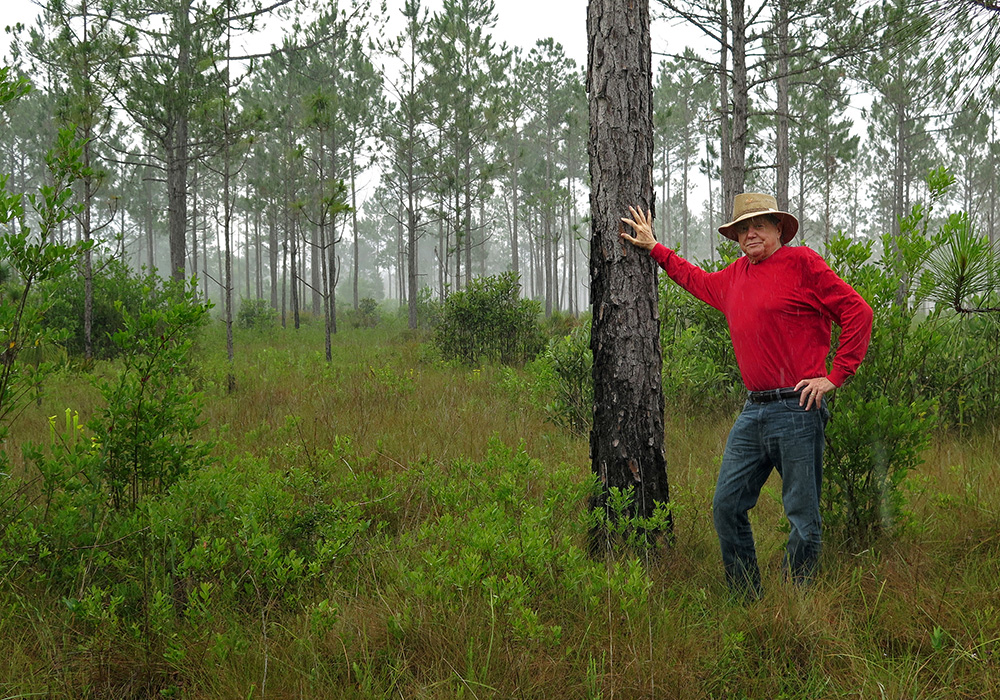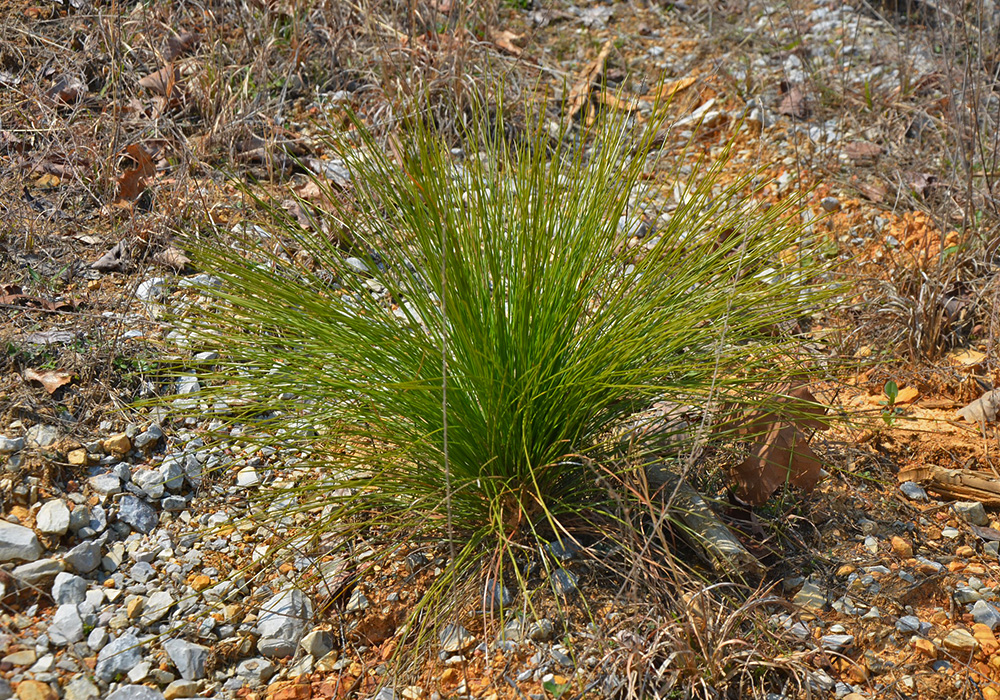By Tony Hiss
Tony, the author of fifteen books, lectures and consults around the world about staving off the biodiversity crisis. This essay is adapted from his book, Rescuing the Planet: Protecting Half the Land to Heal the Earth (Vintage Books, 2022), and is re-published with his permission from his website, Rewilding Successes.
Some years ago, E. O. Wilson, the great conservation biologist, took me on a rewilding field trip to meet M. C. Davis, a friend of his who was growing a forest in the Florida Panhandle. Davis, a multimillionaire commodities trader, grew up there in a trailer and raised his first stake playing poker. Like Wilson, Davis was tireless and an elaborately courteous southern charmer (Wilson hailed from next door Alabama), but there was, Wilson said on the way, one big difference between them: “I only write about saving biodiversity. He’s actually doing it.”
Davis’s idea was to revive the Piney Woods, the signature ecosystem of the American Southeast. A longleaf pine forest once covered 90 million acres, or about 60 percent of a virtually continuous 1,200-mile stretch across nine states from Virginia to Texas. That forest had been reduced by 97 percent, with only about 3 million acres left. Which is more catastrophic than what’s happened to the Amazon rainforest or to coral reefs. The longleaf pine forest’s Big Cut, as it’s still known, began after the Civil War and left behind what’s referred to as “a sea of stumps.”
In 2000, Davis, who was a folksy, slightly rumpled, and unassuming man—“I’m a dirt-road, Panhandle guy,” he told me—began spending half a million dollars a year planting longleaf pine trees, and another half million on other parts of a longleaf forest. He remembered the awakening that started it all.
“Ed set the course by showing us that doing something huge is our only hope.”
– M.C. Davis
He’d gotten stuck in a big pileup on I-4 near Tampa, saw a high-school marquee with the sign BLACK BEAR SEMINAR, and walked in the door: “There was an old drunk, and a politician who’d thought there’d be a crowd, and a couple of Canadians looking for day-old doughnuts and coffee—and, up on the stage, two women were talking about saving bears. They were riveting. The next day I gave those ladies enough money to keep going for another two years—which I think scared them, it was so out of the blue. Then I asked them for a hundred-book environmental reading list for me, for my education. I spent a year reading Thoreau, John Muir, Ed Wilson. Then I started buying land to see what I could do.”
If you were going to save Florida black bears, it was clear, you’d have to save longleaf forests, one of their habitats. An adult male black bear roams across perhaps 120 square miles of land. North Florida already had some good-sized clusters of publicly owned longleaf—national forests, state forest, wildlife management areas, and in the western Panhandle, Eglin Air Force Base, a huge facility that back before World War II had itself been a national forest. If you could add in enough territory to put these pieces together, they’d amount to something greater than a “postage stamp” of the natural world, as conservationists were referring to national parks. The problem was that 70 miles separated the first two protected longleaf forests—and it was another 95 miles to the third.
As Davis dug deeper, he realized the coastal Southeast is a hyperdiverse biological hotspot with up to sixty species in a single square yard—though you might not think so to see it, since a mature longleaf forest looks clipped and kempt, more like a city park. This is a forest with tall, straight trees that are rather widely spaced, letting in plenty of sunlight, and there are lots of open, grassy meadows. A longleaf tree only branches out once it’s high overhead, where glistening needles up to a foot and a half long are arrayed in pompom-like sprays. Below the branches is empty space a hawk can glide through.
Davis’s plan was to buy up and re-longleaf the “in-between” open space east of Eglin and west of a protected corridor along the Choctawhatchee River. The land was close to people, just a few miles inland from the sugar-white sands and high-rise condos of Gulf Coast beach towns. But it was dismal rather than dazzling, a series of abandoned peanut farms and unproductive pulpwood forests.
His approach was called “M. C.’s folly” by conservationists because it seemed too ambitious. But Davis persisted. “Ed set the course,” he told me, “by showing us that doing something huge is our only hope.”
Davis bought 51,000 acres of these degraded farms and forests, assembling a piece of property up to twelve miles wide that included barely 1,500 acres of longleaf pine in scattered patches. Basically, he’d be starting from scratch, creating the biggest private preserve (a site known as Nokuse Plantation) and the biggest restoration project east of the Mississippi.


Even after years of work, much of it was still scruffy. A longleaf reforestation turns out to look like a construction zone, as Davis acknowledged while driving over bumpy trails in a golf cart. “Well,” he said, “I tell people we’re now in year thirteen of a three-hundred-year program. I could easily make a thousand acres look beautiful, but the extinction clock’s ticking, so I decided to take on the bigger challenge.”
Davis and his crew had already thinned 22,000 acres of pulpwood pines and planted 8 million longleaf seedlings on 24,000 acres. He’d also brought flames back to the woods after a half-century absence, setting carefully controlled fires on about 10,000 acres every year. For the past 25 million years, a prominent feature in this coastal environment has been violent summer thunderstorms and strobe-like lightning strikes.
What grew here, uniquely, was a fire-and-rain forest, one that, to stay healthy and keep its open glades, thirsts as much for scorching as it does for drenching—the one starts seeds germinating, the other lets them grow. Longleaf itself only thrives because it has evolved a slow, intricate fire dance that lets it evade being burned. An infant longleaf looks like a clump of ground-hugging grass, and it keeps that humble shape for up to seven years before entering a “rocket stage” and growing four feet straight up, beyond a ground fire’s lethal reach.


A young longleaf pine, looking like a clump of ground-hugging grass
Davis died in 2015; his three-hundred-year mission continues. His forest, now permanently protected and endowed, is still growing, with 3,600 new acres. Something’s already gone right—bears have come back, ambling in from Eglin and then sticking around. Things are even on track to bring back red-cockaded woodpeckers, small, longleaf-nesting birds whose population has been reduced by 99 percent.
Looking far, far into the future, Davis envisioned something grander, as he confided to Wilson and me one starry night out on his porch: finding a place for bison. The area’s last known woodland bison was shot just before the American Revolution.
“Oh, now you’ve got me dreaming,” Wilson said about the bison. “You’ve set my imagination on fire!”

